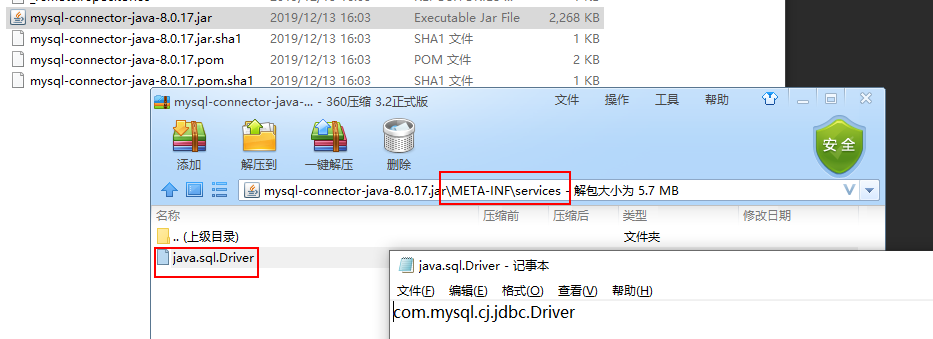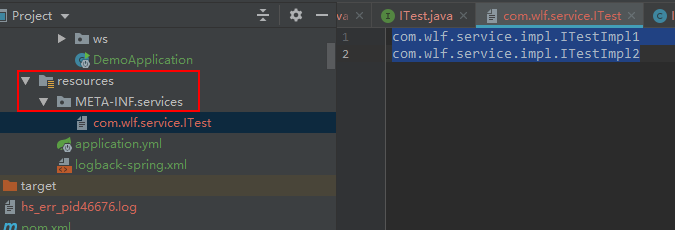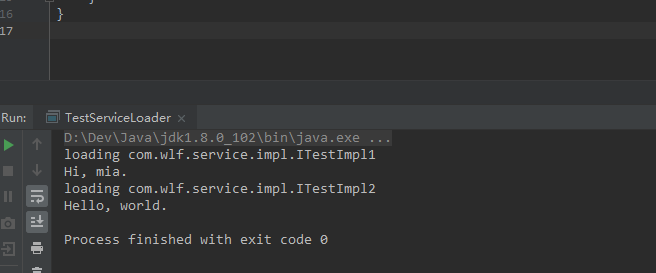JDK有个ServiceLoader类,在java.util包里,支持按约定目录/META-INF/services去找到接口全路径命名的文件,读取文件内容得到接口实现类的全路径,加载并实例化。如果我们在自己的代码中定义一个接口,别人按接口实现并打包好了,那么我们只需要引入jar包,通过ServiceLoader就能够把别人的实现用起来。举个例子,JDK中的JDBC提供一个数据库连接驱动接口,不同的厂商可以有不同的实现,如果它们给的jar包里按规定提供了配置和实现类,那么我们就可以执行不同的数据库连接操作,比如MySql的jar包里就会有自己的配置:

这里文件名就是接口:

文件内容是实现类:

以上就是java的SPI(Service Provider Interface)机制,支持第三方扩展我们的接口实现。我们自己实现一个简单例子,为了省去打jar包的麻烦,把目录放到maven项目结构中的resources下即可,这里就是classpath,跟你放jar包里效果一样。
1、定义一个接口:
package com.wlf.service; public interface ITest { void saySomething(); }
2、定义两个实现:
package com.wlf.service.impl; import com.wlf.service.ITest; public class ITestImpl1 implements ITest { @Override public void saySomething() { System.out.println("Hi, mia."); } }
package com.wlf.service.impl; import com.wlf.service.ITest; public class ITestImpl2 implements ITest { @Override public void saySomething() { System.out.println("Hello, world."); } }
3、按预定新增/META-INF/services/com.wlf.service.ITest文件:
com.wlf.service.impl.ITestImpl1
com.wlf.service.impl.ITestImpl2

4、定义一个执行类,通过ServiceLoader加载并实例化,调用实现类方法,跑一下:
package com.wlf.service; import java.util.Iterator; import java.util.ServiceLoader; public class TestServiceLoader { public static void main(String[] args) { ServiceLoader<ITest> serviceLoader = ServiceLoader.load(ITest.class); Iterator<ITest> iTests = serviceLoader.iterator(); while (iTests.hasNext()) { ITest iTest = iTests.next(); System.out.printf("loading %s ", iTest.getClass().getName()); iTest.saySomething(); } } }
打印结果:

ServiceLoader源码比较简单,可以看下上面我们使用到的标黄了的方法:
/** * Lazily loads the available providers of this loader's service. * * <p> The iterator returned by this method first yields all of the * elements of the provider cache, in instantiation order. It then lazily * loads and instantiates any remaining providers, adding each one to the * cache in turn. * * <p> To achieve laziness the actual work of parsing the available * provider-configuration files and instantiating providers must be done by * the iterator itself. Its {@link java.util.Iterator#hasNext hasNext} and * {@link java.util.Iterator#next next} methods can therefore throw a * {@link ServiceConfigurationError} if a provider-configuration file * violates the specified format, or if it names a provider class that * cannot be found and instantiated, or if the result of instantiating the * class is not assignable to the service type, or if any other kind of * exception or error is thrown as the next provider is located and * instantiated. To write robust code it is only necessary to catch {@link * ServiceConfigurationError} when using a service iterator. * * <p> If such an error is thrown then subsequent invocations of the * iterator will make a best effort to locate and instantiate the next * available provider, but in general such recovery cannot be guaranteed. * * <blockquote style="font-size: smaller; line-height: 1.2"><span * style="padding-right: 1em; font-weight: bold">Design Note</span> * Throwing an error in these cases may seem extreme. The rationale for * this behavior is that a malformed provider-configuration file, like a * malformed class file, indicates a serious problem with the way the Java * virtual machine is configured or is being used. As such it is * preferable to throw an error rather than try to recover or, even worse, * fail silently.</blockquote> * * <p> The iterator returned by this method does not support removal. * Invoking its {@link java.util.Iterator#remove() remove} method will * cause an {@link UnsupportedOperationException} to be thrown. * * @implNote When adding providers to the cache, the {@link #iterator * Iterator} processes resources in the order that the {@link * java.lang.ClassLoader#getResources(java.lang.String) * ClassLoader.getResources(String)} method finds the service configuration * files. * * @return An iterator that lazily loads providers for this loader's * service */ public Iterator<S> iterator() { return new Iterator<S>() { Iterator<Map.Entry<String,S>> knownProviders = providers.entrySet().iterator(); public boolean hasNext() { if (knownProviders.hasNext()) return true; return lookupIterator.hasNext(); } public S next() { if (knownProviders.hasNext()) return knownProviders.next().getValue(); return lookupIterator.next(); } public void remove() { throw new UnsupportedOperationException(); } }; }
我们用到的迭代器其实是一个Map:
// Cached providers, in instantiation order private LinkedHashMap<String,S> providers = new LinkedHashMap<>();
它用来缓存加载的实现类,真正执行的是lookupIterator:
// The current lazy-lookup iterator private LazyIterator lookupIterator;
我们看下它的hasNext和next方法:
public boolean hasNext() { if (acc == null) { return hasNextService(); } else { PrivilegedAction<Boolean> action = new PrivilegedAction<Boolean>() { public Boolean run() { return hasNextService(); } }; return AccessController.doPrivileged(action, acc); } } public S next() { if (acc == null) { return nextService(); } else { PrivilegedAction<S> action = new PrivilegedAction<S>() { public S run() { return nextService(); } }; return AccessController.doPrivileged(action, acc); } }
private boolean hasNextService() { if (nextName != null) { return true; } if (configs == null) { try { String fullName = PREFIX + service.getName(); if (loader == null) configs = ClassLoader.getSystemResources(fullName); else configs = loader.getResources(fullName); } catch (IOException x) { fail(service, "Error locating configuration files", x); } } while ((pending == null) || !pending.hasNext()) { if (!configs.hasMoreElements()) { return false; } pending = parse(service, configs.nextElement()); } nextName = pending.next(); return true; } private S nextService() { if (!hasNextService()) throw new NoSuchElementException(); String cn = nextName; nextName = null; Class<?> c = null; try { c = Class.forName(cn, false, loader); } catch (ClassNotFoundException x) { fail(service, "Provider " + cn + " not found"); } if (!service.isAssignableFrom(c)) { fail(service, "Provider " + cn + " not a subtype"); } try { S p = service.cast(c.newInstance()); providers.put(cn, p); return p; } catch (Throwable x) { fail(service, "Provider " + cn + " could not be instantiated", x); } throw new Error(); // This cannot happen } public boolean hasNext() { if (acc == null) { return hasNextService(); } else { PrivilegedAction<Boolean> action = new PrivilegedAction<Boolean>() { public Boolean run() { return hasNextService(); } }; return AccessController.doPrivileged(action, acc); } }
hasNext查找实现类,并指定了类路径:
private static final String PREFIX = "META-INF/services/";
具体查找操作看这里:
pending = parse(service, configs.nextElement());
next则是实例化加载到的实现类,使用反射Class.forName加载类、newInstance实例化对象。通过jar包引入接口和实现的例子参见Java的SPI引入Jar包简单例子。